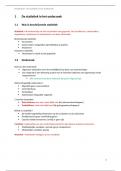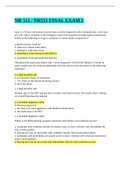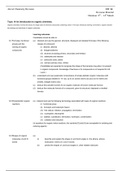Co-ownership
Tenancy in common or joint tenancy?
Types of co-ownership: The common law leans in favour of joint tenancy, but
Co- ownership arises where two or more people have an equity leans in favour of a tenancy in common
interest in one piece of property at the same time S.1 (6) AND s.36 (2) LPA 1925- co-ownership of a legal
estate in land must be as joint tenancy
Two types: There can never be severance of the legal estate
Where two or more people own as joint tenants, they
Joint tenancy- each joint tenant is said to be wholly will be deemed to own as joint tenants in equity under
entitled to the whole of the estate or interest that is the the equitable maxim ‘equity follows the law’’
subject of co-ownership Equity will not follow the law where one of the legal co-
Tenancy in common- each co-owner is said to own a owners can establish exceptional circumstances such as
distinct share or a notional proportion of entitlement it is fair in all the circumstances the shares should be
A joint tenancy in equity may be severed and can unequal (Stack v Dowden, Barton v Morris, Bull v Bull)
become a tenancy in common either in relation to the In these cases the parties will hold as tenants in
whole of the property or for just a single share common
Some factors that will indicate whether the equitable
Joint tenancy: estate is held as a joint tenancy or a tenancy in common.
No tenant owns a specific share The following equitable presumptions indicate a tenancy
Any transfer of the legal title must be carried out by all in common:
the joint tenants together Words of severance- e.g. in equal shares or to be divided
Two main features: between X and Y
The right of survivorship One of the four unities is absent
The for unities Contributions of purchase money in unequal shares. The
share will usually be proportional to the size of the
The right of survivorship: contribution unless there is a contrary indication
Under the Law of Property Act 1925 s.1 (6), a legal
estate is incapable of existing in divided shares Methods of severance of the equitable estate:
On the death of one joint tenant, the estate remains
with the surviving joint tenants Severance by written notice:
The joint tenancy ends when the property vests in a sole S.36 (2) LPA 1925- A joint tenant can sever his share by
survivor giving the other joint tenants a written notice of his
Any attempt to pass an interest in a joint tenancy via a desire to sever the joint tenancy
will is unenforceable because the joint tenant has no The consent of the other joint tenants is not needed for
separate share to leave under their will it to be effective
Since the legal estate automatically vests in the other Severance must take effect during the lifetime of the
joint tenants, there is no need to formally vest the legal joint tenant. It cannot take effect under a will
title in the names of the survivors Re Drapers Conveyance- Notice can be in any form,
summons in court proceedings was sufficient as it
The four unities: showed an immediate intention to sever the joint
Must be present before a joint tenancy exists tenancy
They are: The written notice does not need to be signed or
Possession- Every joint tenant is entitled to every part of witnessed
the co-owned land Kinch v Bullard- Need to prove that it was actually
Interest- The interest must be the same in extent, posed to the other joint tenants even if it was not
nature and duration. No joint tenant can effectively deal actually read by them
with the legal estate on their own Re 88 Berkeley Road- Letter set by recorded post is
Time- The interest of each joint tenant must start at the deemed to be served if it is not returned to the post
same time office
Title- Each joint tenant must take their title from the Harris v Goddard- Written severance will not be
same source effective unless it is to take immediate effect and it must
be served on all the joint tenants
The tenancy in common:
Under a tenancy in common the co-owners hold specific Severance by an act of a joint tenant ‘operating upon
shares in land or a proportional share his share’:
Although each tenant can claim a share, they cannot S. 36 (2) LPA 1925- codifies the pre-1925 methods of
physically separate the property and claim exclusive severance under Williams v Hensman
possession over his share of the property There are three alternatives:
Each tenant in common has the right to enjoy the whole An act operating on a joint tenant’s share
property Mutual agreement
The doctrine of survivorship does not operate on the Mutual conduct
death of a tenant in common and the share can pass First National Securities ltd v Hegerty: Any act of total
under a valid or partial alienation of the joint tenant’s share will be an
Only one of the four unities (unity of possession) need act of severance, e.g. sale or mortgage of their share
be present between tenant in common unless this is fraudulent
Tenancy in common or joint tenancy?
Types of co-ownership: The common law leans in favour of joint tenancy, but
Co- ownership arises where two or more people have an equity leans in favour of a tenancy in common
interest in one piece of property at the same time S.1 (6) AND s.36 (2) LPA 1925- co-ownership of a legal
estate in land must be as joint tenancy
Two types: There can never be severance of the legal estate
Where two or more people own as joint tenants, they
Joint tenancy- each joint tenant is said to be wholly will be deemed to own as joint tenants in equity under
entitled to the whole of the estate or interest that is the the equitable maxim ‘equity follows the law’’
subject of co-ownership Equity will not follow the law where one of the legal co-
Tenancy in common- each co-owner is said to own a owners can establish exceptional circumstances such as
distinct share or a notional proportion of entitlement it is fair in all the circumstances the shares should be
A joint tenancy in equity may be severed and can unequal (Stack v Dowden, Barton v Morris, Bull v Bull)
become a tenancy in common either in relation to the In these cases the parties will hold as tenants in
whole of the property or for just a single share common
Some factors that will indicate whether the equitable
Joint tenancy: estate is held as a joint tenancy or a tenancy in common.
No tenant owns a specific share The following equitable presumptions indicate a tenancy
Any transfer of the legal title must be carried out by all in common:
the joint tenants together Words of severance- e.g. in equal shares or to be divided
Two main features: between X and Y
The right of survivorship One of the four unities is absent
The for unities Contributions of purchase money in unequal shares. The
share will usually be proportional to the size of the
The right of survivorship: contribution unless there is a contrary indication
Under the Law of Property Act 1925 s.1 (6), a legal
estate is incapable of existing in divided shares Methods of severance of the equitable estate:
On the death of one joint tenant, the estate remains
with the surviving joint tenants Severance by written notice:
The joint tenancy ends when the property vests in a sole S.36 (2) LPA 1925- A joint tenant can sever his share by
survivor giving the other joint tenants a written notice of his
Any attempt to pass an interest in a joint tenancy via a desire to sever the joint tenancy
will is unenforceable because the joint tenant has no The consent of the other joint tenants is not needed for
separate share to leave under their will it to be effective
Since the legal estate automatically vests in the other Severance must take effect during the lifetime of the
joint tenants, there is no need to formally vest the legal joint tenant. It cannot take effect under a will
title in the names of the survivors Re Drapers Conveyance- Notice can be in any form,
summons in court proceedings was sufficient as it
The four unities: showed an immediate intention to sever the joint
Must be present before a joint tenancy exists tenancy
They are: The written notice does not need to be signed or
Possession- Every joint tenant is entitled to every part of witnessed
the co-owned land Kinch v Bullard- Need to prove that it was actually
Interest- The interest must be the same in extent, posed to the other joint tenants even if it was not
nature and duration. No joint tenant can effectively deal actually read by them
with the legal estate on their own Re 88 Berkeley Road- Letter set by recorded post is
Time- The interest of each joint tenant must start at the deemed to be served if it is not returned to the post
same time office
Title- Each joint tenant must take their title from the Harris v Goddard- Written severance will not be
same source effective unless it is to take immediate effect and it must
be served on all the joint tenants
The tenancy in common:
Under a tenancy in common the co-owners hold specific Severance by an act of a joint tenant ‘operating upon
shares in land or a proportional share his share’:
Although each tenant can claim a share, they cannot S. 36 (2) LPA 1925- codifies the pre-1925 methods of
physically separate the property and claim exclusive severance under Williams v Hensman
possession over his share of the property There are three alternatives:
Each tenant in common has the right to enjoy the whole An act operating on a joint tenant’s share
property Mutual agreement
The doctrine of survivorship does not operate on the Mutual conduct
death of a tenant in common and the share can pass First National Securities ltd v Hegerty: Any act of total
under a valid or partial alienation of the joint tenant’s share will be an
Only one of the four unities (unity of possession) need act of severance, e.g. sale or mortgage of their share
be present between tenant in common unless this is fraudulent







